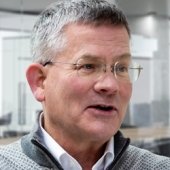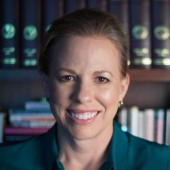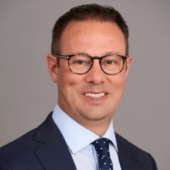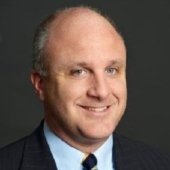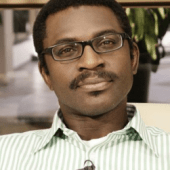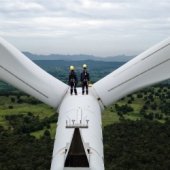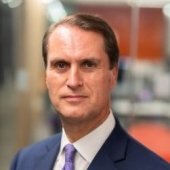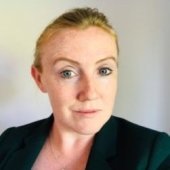IN BRIEF
- 4:15 - Climate change and the need to decarbonize and enhance our resource efficiency, that’s a business imperative. That will require businesses to adapt and innovate, and I do not see any intelligent tenable resistance to that any longer. At best, it’s a matter of time.
- 9:32 - There is a skills gap, and the skills gap would have to be bridged. It cannot be just the conventional financial analysis–led conversation. It has to be a bigger table, and we need folks with an understanding of some of the operational aspects of ESG, folks with a sophisticated understanding of climate risks and their implications for economic growth and financial performance.
- 14:46 - The trifecta of politics, policy and capital, hopefully, will get us to that critical halve-our-emissions milestone by 2030. That’s my overarching big hope, and investors and the financial system, more broadly, have to play a critical role in making that happen.
Sharadiya Dasgupta is a founding partner of Blue Dot Capital where she leads the firm’s strategy, client partnerships and industry engagement and advises CEOs, CIOs and family-office principals. Blue Dot is a sustainable-finance consultancy that partners with financial services firms to support the end-to-end development and execution of ESG and impact-investing programs, capabilities and products. Joe Kornik, Editor-in-Chief of VISION by Protiviti, talks with Dasgupta about the firm’s goals, projects and impact on the future of ESG.
Sharadiya Dasgupta is founding partner of Blue Dot Capital where she leads the firm’s strategy, client partnerships and industry engagement, as well as advising CEOs, CIOs and family-office principals. Blue Dot is a sustainable finance consultancy that partners with financial services firms to support the end-to-end development and execution of ESG and impact-investing programs, capabilities and products.
Podcast transcript
Joe Kornik: Welcome to the VISION by Protiviti podcast. I’m Joe Kornik, Editor-in-Chief of VISION by Protiviti, a global content resource looking into the future to examine the big themes that will impact the C-suite and executive board rooms worldwide. Today, we’re exploring the future of ESG and its strategic implications for people, process and the planet, and I’m happy to be joined today by Sharadiya Dasgupta, founding partner of Blue Dot Capital, where she leads the firm’s strategy, client partnerships and industry engagement, as well as advising CEOs, CIOs and family-office principals. Blue Dot is a sustainable-finance consultancy that partners with financial services firms to support the end-to-end development and execution of ESG and impact investing programs, capabilities and products. Sharadiya, thank you so much for joining me on the podcast today.
Sharadiya Dasgupta: Thank you so much for having me, Joe. Looking forward to the conversation.
Joe Kornik: So, you’re a founding partner, as I mentioned in my introduction there, of Blue Dot Capital. Can you tell me a little bit about Blue Dot and what it does, and how it’s helping to shape the future of ESG?
Sharadiya Dasgupta: We are indeed, as you’ve so elegantly described in your introduction, Blue Dot Capital. We are an ESG and impact-investing consulting firm, and we have a narrow and deep focus on serving the asset management community. We work with investment management firms investing across public and private markets, and support the development of their in-house ESG and impact-investing policies, strategies and program capabilities.
In terms of shaping the future of ESG, well, that’s a great aspiration to have. We are starting out, and it’s not just us as a firm that’s starting out. I think the whole ESG space has so much room to grow in rigor and sophistication, and so much evolution will happen, so it will be prematurely self-congratulatory for me to say if we are shaping the future of ESG. We aspire to. Time will tell. Also, if we do succeed in earning that validation, I want that recognition to come from our clients and partners, and not self-certified, so I won’t comment on that right away.
Having said that, we are fortunate to work on a range of interesting ESG projects with our clients, some of which have pretty novel components, so let me share a small subset with you and your listeners. We are currently working with the investment team of a private market-investment platform to explore and understand, what does a sustainable mobility strategy look like? Sustainable mobility is a big field that involves multiple industries, so we are trying to understand, what are the impact objectives that a private-market investment firm can try if they launch a sustainable-mobility fund? What should be the hierarchy of those objectives and themes? What are some of the unintended consequences that we should be guarding against when designing this investment strategy?
The second example is related to supply chain. As we all know, supply chain continues to be the topic du jour, so we are working with a very large global data company that’s working on developing the blueprint of what an ESG-informed supply chain financing might look like, and we are doing that in partnership with a consortium of leading lenders. So, we do have a front-row seat to see how the ESG conversation is evolving, and we are excited about that.
Joe Kornik: Yes, it sounds like it, and those are some really interesting examples that you just brought up, which is really interesting. And you are in the forefront of the investment that’s happening in ESG, and there’s been a real rush of money into that space—into ESG investment funds—certainly, since the pandemic. Sustainable business has come of age in the last few years. Do you think that movement toward ESG investing is real and lasting, and where do you see it today, and where do you see it going in the future?
Sharadiya Dasgupta: Climate change and the need to decarbonize and enhance our resource efficiency, that’s a business imperative. That will require businesses to adapt and innovate, and I do not see any intelligent tenable resistance to that any longer. At best, it’s a matter of time. It’s your choice as business leaders whether you start acknowledging it now and you’re taking strategic action, or you could buy yourself a little more time and delay by another few years, but there will be some tradeoffs for doing that, but it’s just a matter of time. I don’t think there is a question of whether you need to do it or not.
Parallelly, there are also some immense demographic and socioeconomic shifts happening that have implication for consumer preferences and buying habits, again, that impacts the bottom line and that impacts investment-allocation decisions. To answer your question, the practice of incorporating ESG into business decisions and into investment decisions, that will continue.
However, some of the ways of incorporating ESG and some of the mechanisms that we have practiced will have to evolve and will have to mature. For example, we often hear people—including, if I’m not mistaken, some of your guests on your earlier episodes, have talked about the problem of ESG data. You hear people often complain about the lack of quality ESG data. Regulators, and to a certain degree, market forces will take care of that. Regulators are already setting disclosure regulations for publicly listed companies, for asset management firms. All of that will end up fixing this problem to a large degree.
However, the problem that is not often talked about enough is the lack of education within investment management firms to analyze and draw meaningful insights from the data, because traditionally, the paradigms of investment management do not really have room for a more critical examination of some of these risks and opportunities that we are now talking about.
There has to be reorientation within investment management firms that force them to take a more expansive view of risks and opportunities. I hope that over the years to come, there is greater sophistication in how investment management firms analyze the ESG data that’s coming their way, and this cannot just be led by the ESG functions in the investment firm. This has to be truly cross-functional. There has to be buy-in from investment teams, and investment teams will also have to develop this capacity to analyze and critically examine this data. There has to be a cross-pollination between disciplines happening here. This cannot just be the responsibility of the ESG and climate teams of companies.
That’s one prediction as to how it will evolve, and my other prediction is that there has to be a disaggregated examination of ESG. ESG is convenient. It’s a convenient acronym and a convenient way to organize information. But E, S and G are such broad topics, and an expression like ESG can end up being reductive, so now there will be a trend away from using ESG as a catch-all, and sophisticated investment firms will have to develop capabilities and research functions that have the capacity to do a more critical and nuanced examination of the components of ESG and the subcomponents that are relevant to their investment theses and their investment philosophies. The gist is that the investment management profession will have to become more sophisticated in how they dissect and examine ESG information.
Joe Kornik: Interesting. I feel like both aspects of that answer did talk about talent and skills and capabilities, and I’m wondering: You mentioned that more rigorous analysis of the data is necessary. Do you think that’s just a tweak to reposition some existing professionals in these firms, or do you think that’s systemic? Are we not developing those skills and capabilities even at the B-school level or university level? Do you see a skills gap, I guess, is what I’m getting at around data and analysis as we move through the next several years.
Sharadiya Dasgupta: It’s a skills gap. You say that correctly. There is a skills gap, and the skills gap would have to be bridged. It cannot be just the conventional financial analysis–led conversation. It has to be a bigger table, and we need folks with an understanding of some of the operational aspects of ESG, folks with a sophisticated understanding of climate risks and their implications for economic growth and financial performance, so it is a skills gap.
But the good news is that there are enough initiatives already afoot that are tackling this problem of a skills gap. I know universities that have launched multicollaborative research efforts that have participation from the financial services industry, that have participation from academia and some of the other disciplines needed that we just talked about to broaden and deepen our understanding of the interplay of ESG and financial performance. Institutions like the CFA Society and CAIA, they will increasingly take a bigger role in making sure that investment management firms have the tool kit needed to continue to future-proof their investment decisions. A lot more is needed, but we are off to a good, promising start.
Joe Kornik: I mentioned in my introduction that Blue Dot also advises CEOs and CIOs, so I’d be curious: What’s the advice? When you advise business leaders on sustainable investing, for instance, what are some of the biggest challenges they’re facing? What are their needs, what are their questions and what is your advice to those business leaders on overcoming or navigating those challenges?
Sharadiya Dasgupta: One of the challenges that leadership teams are facing is how to balance the now with the 2030 or the 2050 goals, and it’s not easy. Just with the geopolitical developments and uncertainty, the energy-transition conversation now has connotations about energy security, etc., so a number of CIOs and business leaders have had to reevaluate their stance on fossil fuel investing and how they still continue to be an enabler in the decarbonization process that has to happen. Is it just a momentary hiccup? Does it have ramifications for medium-term plans?
It sounds sprawling and messy, and it is sprawling and messy, so we do not always have neat answers, and we are lucky to have clients who understand that there are no silver bullets, so the advice that we give our clients is to make sure that they are budgeting for and they are accounting for the long-term trends and that, as stewards of capital, they’re not taking their eyes off what are the long-term directional trends, but then, in that short to medium term, they are adjusting for some of the variability that we just talked about. That’s the biggest challenge that business leaders are facing.
Joe Kornik: You mentioned long-term quite a few times there in your answer, and you led me into my final question of the podcast, which is, if I were to ask you to look out a decade or more — this is VISION by Protiviti, so we like to bring smart people to the table and ask them to give us their vision of the future and where we’re headed in a decade or even more. We could even go all the way out to 2035, which is a nice, round number. What do you see in the investment space? How much progress do you think we’ll have made, or where do you think we’ll be, or what kind of world do you think we’ll be looking at in this space in, let’s say, 2035?
Sharadiya Dasgupta: Let me shift the timeline to 2030—2030 is a major milestone and we have a major climate milestone for collective humanity’s sake we should be able to reach, and I do want to be optimistic about it. We have to halve emissions by 2030, and I hope that we have achieved that, or we are not perilously away from achieving that goal by 2030. Some of the technology needed to take us there already exists. It’s a matter of scaling that technology. It’s a matter of making sure that the capital continues to flow toward those technologies.
And then, in some cases, we do not have the technology ready, but our human ingenuity can definitely come into play, and there is so much innovation that has just happened in the last decade or so. There is no reason to not expect that to continue. So, the trifecta of politics, policy and capital, hopefully, will get us to that critical halve-our-emissions milestone by 2030. That’s my overarching big hope, and investors and the financial system, more broadly, have to play a critical role in making that happen.
I also hope that by 2030, the elements of equity are fundamentally entrenched in the climate-change conversation. The climate-change discourse has major implications for equity, and the ideas of equity within countries—even within, let’s say, the United States. Predominantly, or to a large extent, the most brutal impact of climate change will be felt by the historically disadvantaged communities. So, again, you cannot have effective climate policy if you are not taking into account those considerations, but it’s not only within countries. Globally, again, the climate-change conversation has major ramifications for the capital flow into developing countries and to frontier economies.
So, I hope that, as I said, the trifecta of policy, politics and capital gets to a point by 2030, whereby these considerations of equitable growth are just inextricably entrenched into the climate-change conversation. Those would be my hopes and goals for 2030. To tie it back to how we are shaping the future of ESG, I hope that Blue Dot, along with all our peers and the financial services industry and other professional services firms like Protiviti, that we all play a role in making that happen.
Joe Kornik: You sound optimistic. Do you think that we’ll get there? Do you think we’ll be in a good spot in 2030?
Sharadiya Dasgupta: I woke up and chose hope today. You’ve caught me on a good day, so, yes, I am choosing to be hopeful today. As ESG professionals, it’s not always easy to hang on to hope. Obviously, there have been a few curveballs, especially on the political and policy-making side of things, which has been disappointing, but as professionals in the space, if we don’t hold on to hope, it will difficult for us to focus on action. Sometimes, the change and the progress feels incremental, but hopefully, it will all add up and we will be doing whatever it needs for us to get to that 2030 milestone or, as I said, at least in the ballpark so that we are not in for a major climate calamity for us and the future generations.
Joe Kornik: Well, hopeful seems like a really good place to end this podcast. Thanks, Sharadiya. This was fun and informative.
Sharadiya Dasgupta: Thank you, Joe. Thank you again for having me.
Joe Kornik: Thank you for listening to the VISION by Protiviti podcast. Please rate and subscribe wherever you listen to podcasts, and be sure to check out Vision.Protiviti.com to view all of our insights and content around the Future of ESG theme that we’re currently working. On behalf of Sharadiya, I’m Joe Kornik. Thanks for listening. We’ll see you next time.
Did you enjoy this content? For more like this, subscribe to the VISION by Protiviti newsletter.






